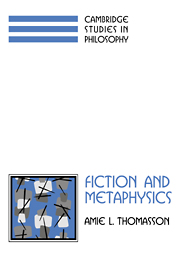Introduction: From Fiction Into Metaphysics
Published online by Cambridge University Press: 23 September 2009
Summary
Although examples from fiction and mythology have long provided a source of interesting puzzles and counterexamples that have guided the development of theories from Frege to Russell to Kripke, fiction has been seen as a sideshow issue in metaphysics. Even the Meinongian minority, which has done much to bring the topic of fiction back into discussion, has done little to dispel the image of fiction as a strange metaphysical jungle beyond the boundaries of traditional metaphysics.
Lying behind the sideshow view of fiction is an assumption shared by believers and disbelievers in fictional objects alike: Fictional characters are (if anything) odd, freakish entities, quite unlike common or garden objects. Disbelievers have used the supposed freakish nature of fictional entities as grounds for rejecting them, alleging that they would be too unruly to accommodate in a theory and fearing that by handling such oddities we will be led into contradiction. Believers have boldly, smilingly embraced their odd creatures, proposed special ontological realms to house them, and shown how, by handling them carefully, we can accommodate their curious tendencies and avoid contamination by contradiction.
The key to seeing the centrality of fiction in metaphysics lies in giving up this assumption and recognizing the similarities between fictional objects and other entities. In the view I propose here, fictional characters are abstract artifacts – relevantly similar to entities as ordinary as theories, laws, governments, and literary works, and tethered to the everyday world around us by dependencies on books, readers, and authors.
- Type
- Chapter
- Information
- Fiction and Metaphysics , pp. xi - xiiPublisher: Cambridge University PressPrint publication year: 1998



